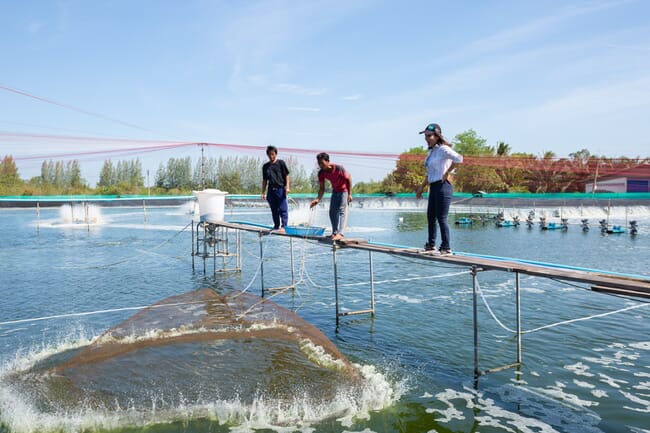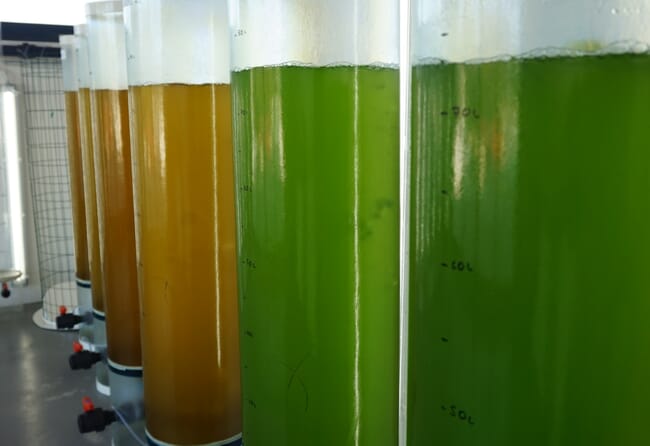
© CAT
“It isn’t about either/or, it’s all of the above,” Kingfish Company CEO Ohad Maiman said during a panel discussion on scaling alternative aquafeed ingredients at the recent Animal AgTech Innovation Summit. The panel, which also featured industry leaders from Cargill, Aqua-Spark* and Deep Branch dived into the current production and investment landscape for sustainable aquafeed ingredients.
Though the industry is coming closer to producing a fully sustainable aquafeed, the panel agreed that eliminating conventional marine ingredients like fishmeal and fish oil is unlikely in the near-term. Sustainable aquafeed ingredients will probably supplement conventional feed ingredients for the next decade until they can scale production.
Aquafeed’s sustainability challenge
The bulk of aquaculture’s carbon footprint comes from aquafeed. Finfish and crustacean species have traditionally relied on protein-dense feed sources like fishmeal and soy to thrive – but aquafeeds can’t rely on these ingredients for much longer.
Aquaculture producers and feed companies are currently looking for new and sustainable ingredients that could revolutionise the feed industry. The ability to reduce and eventually replace marine ingredients like fishmeal and fish oil without sacrificing farm efficiency would make the sector more sustainable. Some promising alternative feed ingredients are entering the market, but they can only make a positive impact if they are produced at scale.

The current landscape in sustainable aquafeed
Peter Rowe, CEO and co-founder of Deep Branch explained that feed producers must front-load capital before alternative aquafeeds can be commercialised. His startup produces proton, a single-cell protein (SCP) derived from CO2 that can be used as an aquafeed ingredient for Atlantic salmon.
Rowe said that he had to build strong relationships on both sides of the value chain to validate Deep Branch’s technology and ensure that the bioprocesses were well executed. The CO2-based feed could be a sustainability game-changer – but scaling production to be price competitive with conventional feed ingredients is the challenge. According to Aqua-Spark co-founder Mike Veilings, Rowe and other innovators in sustainable aquafeeds need investors with deep pockets and a long-term vision to make an impact.
Companies that produce and use sustainable feed ingredients are also reliant on consumers to maintain the sector’s momentum. For Ohad Maiman, consumers who fall into the “early adopter” category are footing the bill, as his yellowtail RAS company progressively reduces marine ingredients in their aquafeed in favour of more sustainable options. Rowe largely agrees – saying that courting early adopters is key for an impactful product.
Maiman said that his customers are looking beyond fish-in-fish-out (FIFO) measures in his feed strategy. “We had inquiries on what it would take to produce yellowtail kingfish on 100 percent alternative ingredients,” he explained. But after running the numbers, the company found that completely replacing marine ingredients would be prohibitively expensive. “There were no takers,” he told the panel.
However, Maiman and his colleagues learned that they can substantially reduce marine ingredients in their feed and supplement it with sustainable alternatives without impacting overall productivity. Though their yellowtail is sold at a premium, some consumers weren’t discouraged. “[With] a combination of reducing marine ingredients, constantly adding sustainable ones and aspiring to that place where it is cost-effective to replace them is the best we can do at this point.”
Veilings thinks that sustainable aquafeeds will be used to supplement conventional protein ingredients instead of completely replacing them. The supplementation strategy will go a long way towards improving aquaculture’s carbon footprint, but in his view, total replacement of soy, fishmeal and fish oil will take decades. A sustainable aquafeed revolution isn’t on the immediate horizon.
The investor’s perspective
Speaking as an investor, Veilings said that sustainable feed companies need to focus on bringing costs down in order to scale up. They cannot operate at a premium price point forever.
Many of these feed companies produce protein sources from seaweeds, insects and SCPs that have to be cut with bulk ingredients. This might work during the pilot stage, but startups need to focus on being economically viable and creating standalone products. If sustainable feed remains expensive, then it should also offer aquaculture producers enhanced nutritional features to justify the price premium.

Cecile Lassalle, formulation and cost pricing director for Cargill Inc, told delegates that sustainable aquafeed ingredients have the potential to break into other markets – helping them scale and cut costs.
She explained that many of the innovative protein sources could be used to formulate livestock feed and pet food. Both market segments are in a drive to reduce or replace the amount of soy, palm oil, fish oil and fish meal in their product portfolios. Innovations in sustainable aquafeed could be easily leveraged across three markets instead of one.
“Pet food may actually be a better-paying market than aquafeed,” Lassalle said.
Potential opportunities
When asked about the trajectory of sustainable aquafeeds, Lasalle told the panel that the industry must first identify what it wants to achieve with alternative ingredients. In her view, there are two major push factors that underpin the sustainable feed sector: the need to replace marine ingredients and the need to reduce carbon emissions overall. Because of this, she is mainly focusing on microalgae.
Lasalle says that the microalgae segment is closer to industrial scale than other alternative ingredients. It can also have a positive climate impact (seaweed naturally sequesters atmospheric carbon) and provide a source of omega-3 fatty acids without using fish meal or fish oil. It is also comparatively economical in comparison to other sustainable protein sources. Microalgae will form part of Cargill’s sustainability strategy going forward.

© Algared
Lasalle also told delegates that insect meal is on the cusp of scaling. Some insect-based aquafeeds are being produced, but the industry needs to build capacity before taking off. She also spotlighted single-cell proteins and mycoproteins as promising feed ingredients. Veilings agreed, telling delegates that Aqua-Spark expects to add mycoprotein fermentation to its investment portfolio in the near future.
The long-term vision
Lasalle believes that aquafeed producers need to conduct further research on their products. This will let them determine the optimal inclusion level for sustainable feed ingredients – and the amount of marine ingredients they can forgo without sacrificing quality metrics.
For Maiman, adopting sustainable aquafeed ingredients won’t spell the end of conventional marine ingredients. Instead, scaling sustainable feed sources will improve aquaculture’s carbon footprint without passing the expenses to consumers. “100 percent replacement isn’t the goal,” he said.
“If aquaculture is going to double, or potentially triple by mid-century, we are going to need over 200 million tonnes of extra ingredients compared to where we are today,” Veilings said. It will take decades of investment and a broad portfolio of ingredients to build that capacity.
The Animal AgTech Innovation Summit was held between 19 and 20 October.
*Hatch Blue is part of Aqua-Spark's investment portfolio, but The Fish Site retains editorial independence.




